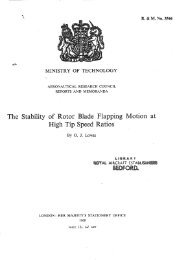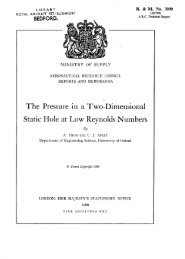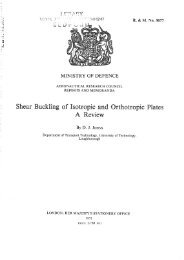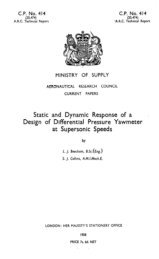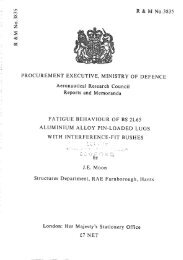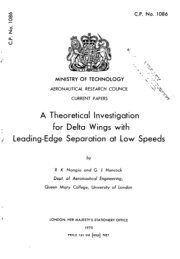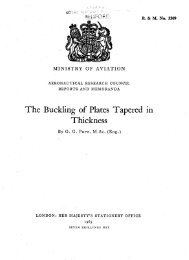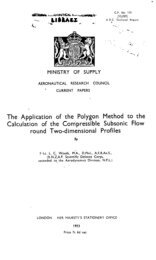The Influence of Surface Waves on the Stability of a ... - aerade
The Influence of Surface Waves on the Stability of a ... - aerade
The Influence of Surface Waves on the Stability of a ... - aerade
Create successful ePaper yourself
Turn your PDF publications into a flip-book with our unique Google optimized e-Paper software.
<str<strong>on</strong>g>The</str<strong>on</strong>g> analysis 1s carried out ln detail m Appendix I. It is shown <strong>the</strong>re<br />
that <strong>the</strong> ma@itude <str<strong>on</strong>g>of</str<strong>on</strong>g> <strong>the</strong> perturbati<strong>on</strong> functi<strong>on</strong> F increases as A.<br />
decreases, so that in general <strong>the</strong> shorter <strong>the</strong> wavelength or <strong>the</strong> lower<br />
<strong>the</strong> sucti<strong>on</strong> velocity for a f'lxed i , <strong>the</strong> more a wave <strong>on</strong> <strong>the</strong> surface<br />
disturbs <strong>the</strong> pr<str<strong>on</strong>g>of</str<strong>on</strong>g>ile shape.<br />
<str<strong>on</strong>g>The</str<strong>on</strong>g> displace!wnt and momentur! thicknesses 6' and 0 and <strong>the</strong><br />
form parameter H =‘$ maybe calculated from <strong>the</strong> vel&ty pr<str<strong>on</strong>g>of</str<strong>on</strong>g>ile (2),<br />
and are periodic about <strong>the</strong> mean vaLucs I, $ and 2 respectively. In<br />
Fig.2 examples are shown <str<strong>on</strong>g>of</str<strong>on</strong>g> <strong>the</strong> velocity pr<str<strong>on</strong>g>of</str<strong>on</strong>g>iles at different points <strong>on</strong><br />
a wavelength, toge<strong>the</strong>r with <strong>the</strong> variati<strong>on</strong> <str<strong>on</strong>g>of</str<strong>on</strong>g> H,B and <strong>the</strong> (n<strong>on</strong>-dunensi<strong>on</strong>al)<br />
velocity U, at tbz edge <str<strong>on</strong>g>of</str<strong>on</strong>g> <strong>the</strong> boundary layer, for <strong>the</strong> values *X = 1,<br />
h = 0.125 and h = 10~-3/2 = 0.03162. [<str<strong>on</strong>g>The</str<strong>on</strong>g> valu3 <str<strong>on</strong>g>of</str<strong>on</strong>g> ao = Z$? has been<br />
chosen in each case to give an appreciable variati<strong>on</strong> in pr<str<strong>on</strong>g>of</str<strong>on</strong>g>ile shape;<br />
for h = I this requires a0 = 0.1, which is much larger than <strong>the</strong><br />
practical values anticipated.]<br />
Ths pr<str<strong>on</strong>g>of</str<strong>on</strong>g>ile with lowest (R6+)orit in a wavelength IS that for<br />
which H is greatest. (Rg+)crlt corresp<strong>on</strong>ding to this pr<str<strong>on</strong>g>of</str<strong>on</strong>g>ile has been<br />
calculated as a functi<strong>on</strong> <str<strong>on</strong>g>of</str<strong>on</strong>g> h and !? , using <strong>the</strong> fact that (R )<br />
S* cr<br />
for a range <str<strong>on</strong>g>of</str<strong>on</strong>g> pr<str<strong>on</strong>g>of</str<strong>on</strong>g>ile shapes invest&ted by several authors has been<br />
found3 to be a single functi<strong>on</strong> <str<strong>on</strong>g>of</str<strong>on</strong>g> H. Tbxs applicability <str<strong>on</strong>g>of</str<strong>on</strong>g> this result<br />
for a pr<str<strong>on</strong>g>of</str<strong>on</strong>g>ile <str<strong>on</strong>g>of</str<strong>on</strong>g> <strong>the</strong> present family has been tested and found satisfactory.<br />
[Append= II].<br />
l?or <strong>the</strong> pr<str<strong>on</strong>g>of</str<strong>on</strong>g>iles c<strong>on</strong>sIdered R 6u has to <strong>the</strong> first order its value<br />
for <strong>the</strong> asymptotic pr<str<strong>on</strong>g>of</str<strong>on</strong>g>ile, namely u.<br />
ys<br />
Thus<br />
For <strong>the</strong> asymptotic pr<str<strong>on</strong>g>of</str<strong>on</strong>g>ile (RS*)crlt = 4 x I&. Thus <strong>the</strong> c<strong>on</strong>diti<strong>on</strong> <str<strong>on</strong>g>of</str<strong>on</strong>g><br />
keeping fi <strong>the</strong> same #hsn <strong>the</strong>re are'waves in <strong>the</strong> surface <str<strong>on</strong>g>of</str<strong>on</strong>g> length L and<br />
height h as when <strong>the</strong> surface is devoid <str<strong>on</strong>g>of</str<strong>on</strong>g> waves and <strong>the</strong> sucti<strong>on</strong> velocity<br />
is vs 0 ' may be written<br />
<strong>the</strong> range 6 x IO3 - 106,<br />
, and thus,for fixed $ and F , '<br />
value<str<strong>on</strong>g>of</str<strong>on</strong>g> $. corresp<strong>on</strong>ding<br />
(6). <str<strong>on</strong>g>The</str<strong>on</strong>g> re<s,<br />
against +Q, for four values <str<strong>on</strong>g>of</str<strong>on</strong>g> y in<br />
Vs t<br />
In <strong>the</strong> curves shown $-a- as o,+O. <str<strong>on</strong>g>The</str<strong>on</strong>g> value <str<strong>on</strong>g>of</str<strong>on</strong>g><br />
0<br />
u<br />
however ra<strong>the</strong>r meaningless under <strong>the</strong>se c<strong>on</strong>diti<strong>on</strong>s; vs itself<br />
vs<br />
-<br />
v%<br />
still<br />
is<br />
has<br />
a small finite value. If vs were plotted agaznst vs , <strong>the</strong> result would<br />
be a series <str<strong>on</strong>g>of</str<strong>on</strong>g> 1~~s <str<strong>on</strong>g>of</str<strong>on</strong>g> slope approximately 1, with mn?ercepts <strong>on</strong> <strong>the</strong> vs<br />
- 6-



